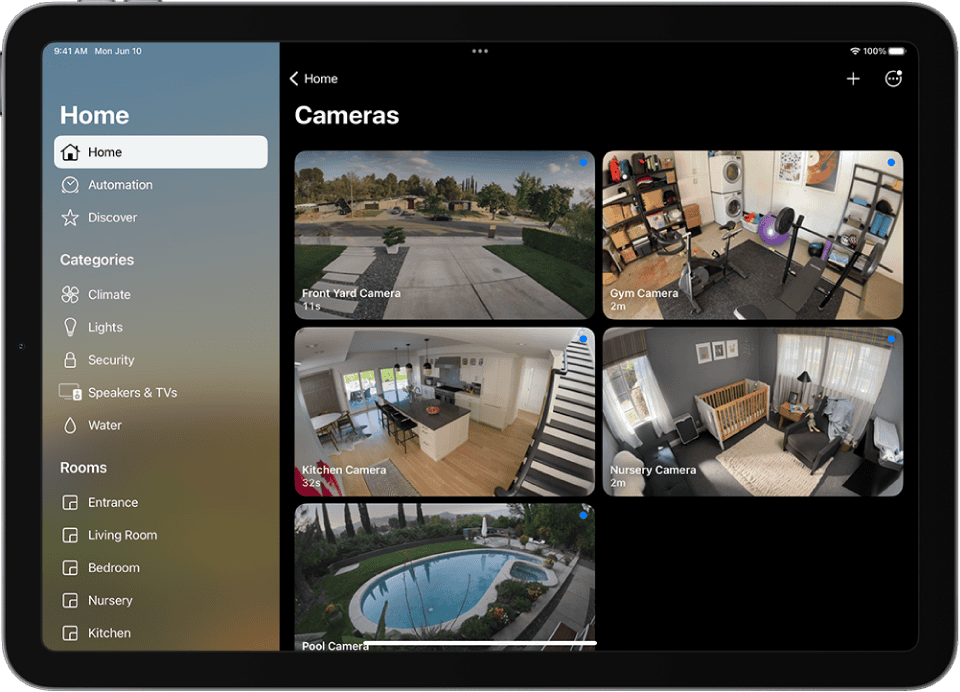Apple plans to launch an AI-powered homepod wall mounted tablet to improve home automation in the first quarter of 2025 (around March). This combination home control system / tablet will act as a main control center for all your smart home devices, security, surveillance, and more. It will also allow users to make video calls and run apps using artificial intelligence. Apple aims to release this AI-driven smart home display early in the year but it could get pushed back if it isn’t ready just yet.
Unofficially, it may be called Homepad, blending the names HomePod and iPad. This innovative product is designed to manage smart home technology while keeping users connected through video calls. Apple is aware of the growth possibilities in the smart home market. With the upcoming launch, the company hopes to attract users and change how they engage with home automation.

The focus on user-friendly design, voice control, and advanced features shows Apple’s commitment to leading in smart home innovation. As user needs change, technology must also adapt. Apple is in the spotlight, and as the launch date nears, both tech fans and everyday consumers are eager to see what Apple will offer for the future of home automation.
This article looks at the possible features, uses, and competition for Apple’s new smart home device, highlighting how it could change the way we interact with connected homes.
Apple’s AI-Powered Home Hub: A Wall Tablet for the Connected Home
Apple is reportedly developing a wall-mountable smart home device that could revolutionize home automation. This AI-powered tablet is expected to act as a central control hub for smart home appliances, offer video calling capabilities, and run apps with the help of artificial intelligence.
Features and Functionality
This new device, codenamed “J490,” is rumored to feature a 6-inch display, similar in size to two iPhones side-by-side. It will likely feature a touch-based interface and integrate seamlessly with Apple’s HomeKit framework. The device is expected to leverage Apple Intelligence, the company’s new AI platform, for advanced automation and control.
Potential Use Cases
- Smart Home Control: Manage lights, thermostats, locks, and other connected devices.
- Video Calls: Communicate with family and friends using FaceTime.
- Entertainment: Stream music and videos, view photos, and access entertainment apps.
- Information Hub: Get news updates, weather reports, calendar reminders, and more.
- AI-Powered Assistance: Use Siri for voice control, automation, and personalized recommendations.
Release Date and Pricing
Bloomberg reports that Apple could unveil this new device as early as March 2025. Pricing is still uncertain, but estimates suggest a premium version could cost up to $1,000, while a display-only model might be significantly less.
Competition in the Smart Home Market
This new device will position Apple to compete more directly with existing smart home displays like:
- Amazon Echo Show 15: A 15.6-inch wall-mountable display with Alexa integration.
- Google Nest Hub Max: A 10-inch display with Google Assistant that can be placed on a stand or wall-mounted.
Apple’s Expanding Smart Home Ecosystem
| Feature | Apple Wall Tablet (Rumored) | Amazon Echo Show 15 | Google Nest Hub Max |
|---|---|---|---|
| Display Size | 6 inches | 15.6 inches | 10 inches |
| AI Assistant | Siri | Alexa | Google Assistant |
| Smart Home Integration | HomeKit | Alexa | Google Home |
This wall-mountable tablet could be a key addition to Apple’s growing smart home ecosystem. It would complement existing devices like the HomePod and Apple TV, offering a more visual and interactive way to manage your connected home.
The Rise of Ambient Computing
The development of this wall tablet aligns with the growing trend of ambient computing. This concept envisions technology seamlessly integrated into our surroundings, providing information and assistance without requiring direct interaction. Devices like smart displays, speakers, and wearable technology contribute to this vision of a more connected and intuitive living environment.
Short Summary:
- Apple’s upcoming smart home display features a 6-inch screen and integrates a host of functions including smart home controls and video calls.
- Designed to enhance users’ control over their environment, it incorporates Apple Intelligence and works seamlessly with existing Apple products.
- The device will be available in black and silver, and Apple is focusing on affordability to compete with rival products from Amazon and Google.
The upcoming smart home display by Apple, reported by Bloomberg’s Mark Gurman, is set to become a game-changer in the smart home landscape. This innovative device will measure approximately six inches, presenting a square form factor that differentiates it from traditional rectangular iPads. With an integrated camera on the upper front, users can engage in FaceTime conversations, while built-in speakers and a rechargeable battery enhance its functionality.
As part of its enhanced smart home ecosystem, Apple plans to offer the display in sophisticated black and silver finishes. A touch-based interface will allow users to navigate effortlessly through its features. The operating system is expected to blend elements from iOS and watchOS, emphasizing voice control capabilities through Siri and the new Apple Intelligence system. According to Gurman, the focus on voice commands is central to the user experience, streamlining operations across connected devices.
“Apple aims to position this display as a command center for the home, integrating seamlessly with existing Apple technologies to control smart home appliances,” stated Gurman.
Central to the device’s appeal is its customizable home screen. Users will be able to showcase vital information like weather updates, appointments, and even photo slideshows. A software-based dock will make accessing applications intuitive, while multiple displays throughout a home will double as intercoms, enhancing communication within the space. Security features are also integral, offering alerts and live camera feeds from associated smart home devices.
Proximity sensors will be a standout feature, allowing the display to adjust its interface based on how close a user is. For instance, when unoccupied, the display may show ambient information such as room temperature; but as a person approaches, it can switch to an interface allowing users to adjust the thermostat, echoing the functional sophistication of popular smart devices like the Nest thermostats. There are discussions about additional external sensors that might connect to standard outlets around the house, although it remains uncertain if Apple will manufacture these accessories.
The device is expected to include several pre-installed Apple applications, providing functionalities like browsing through Safari, listening to Apple Music, managing Notes, and scheduling through Calendar. However, contrary to user expectations, there will not be an App Store available for the device, streamlining the user experience but limiting application options.
“Apple is committed to enhancing the user experience by eliminating complexities; users will have access to the essential applications used daily,” remarked an anonymous source familiar with Apple’s strategy.
The smart display’s design also anticipates the creation of various offline attachments. Among these are a base featuring additional speakers for enhanced audio capabilities, and mounts for convenient wall installation, thereby catering to a variety of home layouts and user preferences.
Apple is determined to strengthen its position in the rapidly evolving smart home market, a sector where competition is undeniably fierce. The upcoming smart home hub has reportedly been in development for over three years, with Apple CEO Tim Cook emphasizing its importance to both design and engineering teams. Despite functioning as a standalone device, initial setup will necessitate an iPhone, ensuring tight integration with Apple’s ecosystem—an approach Apple regards as essential for user convenience.
In setting a competitive price point for the device, analysts speculate that it will fall within the same range as rival products like Amazon’s Echo Hub, priced at $150, and Google’s Nest Hub Max, which retails at about $230. This pricing strategy suggests Apple seeks to make the hub accessible while still delivering premium features.
“To compete effectively with Amazon and Google, Apple must find a balance between quality and affordability,” said an unnamed industry analyst.
Looking ahead, there are whispers of even more ambitious projects in Apple’s pipeline, with analysts including Ming-Chi Kuo suggesting the possibility of a smart home camera with wireless connectivity expected to launch in 2026. While Apple has not officially confirmed plans to create its own range of smart home accessories, the success of the smart display may well pave the way for such developments.
In an intriguing twist, reports hint at a future iteration of the smart display that may involve a robotic arm capable of following users around. Gurman indicates that this advanced version would provide a highly interactive user experience, with an estimated price point closer to $1,000, given its sophisticated technology.
As Apple ventures deeper into the smart home arena, this upcoming wall-mounted display stands to be a pivotal product in redefining how users interact with their connected environments. By offering intuitive control, robust security features, and seamless integration with existing devices, Apple is setting the stage for a noteworthy entry into a competitive marketplace.







